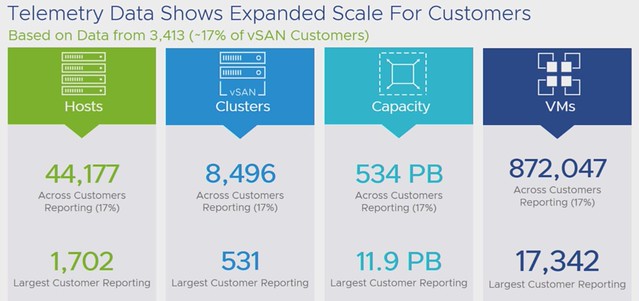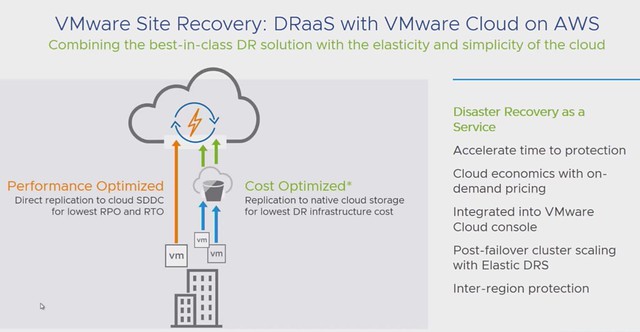At VMworld, various cool new technologies were previewed. In this series of articles, I will write about some of those previewed technologies. Unfortunately, I can’t cover them all as there are simply too many. This article is about HCI / vSAN futures, which was session HCI2733BU. For those who want to see the session, you can find it here. This session was presented by Srinivasan Murari and Vijay Ramachandran. Please note that this is a summary of a session which is discussing the roadmap of VMware’s HCI offering, these features may never be released, and this preview does not represent a commitment of any kind, and this feature (or it’s functionality) is subject to change. Now let’s dive into it, what is VMware planning for the future of HCI? Some of the features discussed during this session were also discussed last year, I wrote a summary here for those interested.
Vijay kicked off the session with an overview of the current state of HCI and more specifically VMware vSAN and Cloud Foundation. Some of the use cases were discussed, and it was clear that today the majority of VMware HCI solutions are running business-critical apps on top. More and more customers are looking to adopt full stack HCI as they need an end-to-end story that includes compute, networking, storage, security and business continuity for all applications running on top of it. As such VMware’s HCI solution has been focussed on lifecycle management and automation of all aspects of the SDDC. This is also the reason why VMware is currently the market leader in this space with over 20k customers and a market share of over 41%.
What I found interesting were some of the customer details being shared in terms of sizes, this is based on telemetry data, and the largest customer reporting telemetry back to VMware has over 1700 hosts running vSAN. The largest customer has over 530 clusters, and the largest reported vSAN datastore is 12PB. Although Vijay mentioned that he knows of 2 customers (black sites, as such not included in the report) that have 100PB and 80PB respectively. I feel these are decent sized environments, and I think most people would agree with me on that.

This is when Vijay started what is coming next for VMware’s hyperconverged infrastructure strategy. The first part of the strategy is ensuring VMware HCI solution runs well everywhere and in a consistent manner (On-Prem, Cloud, Edge), the second part is delivering data management capabilities, and the third part is enabling cloud native applications, and fourth is all about the self-driving data center. Vijay then started diving into each of these areas of investment.

First real topic discussed was the different types of hardware becoming more generally available (and affordable), solutions like NVMe and especially persistent memory (NVDIMM / PMEM) were introduced and customers are starting to figure out what the use cases are for it. How can we use these new types of hardware? VMware has already made a lot of optimizations to the core storage stack to ensure the hypervisor is optimized for faster devices. For instance, the introduction of a virtual NVMe device has resulted in an (up to) 61% latency reduction, and an increase in throughput/IOPS which now is equal to bare metal. The next step is to ensure vSAN can leverage these devices in a smart way, as such the platform should move towards an architecture which is optimized for PMEM / NVMe. As Vijay mentioned, vSAN should allow you to store data on the right type of media.

More specifically, VMware is looking to have vSAN be the control plane for PMEM devices. The challenge today with PMEM is that many of the hypervisor features you love and use are not supported. When managed through vSAN this should allow the user to use these features and services. Next what was discussed was the ability to disaggregate Compute & Storage. Vijay mentioned that especially the larger customers have asked for this. They love the HCI management model as it allows the virtualization admin to manage compute and storage as a single entity, but at certain scale management of storage capacity becomes more complex. What VMware is investing in and looking into is the ability to share vSAN storage capacity across all clusters. Allowing to better share resources across clusters, but also, for instance, allowing for “compute only nodes” which can connect to a vSAN datastore which is presented from a different cluster.

Next discussed was Full Stack HCI management. Here we are talking about deploy, update, monitor and maintain. So not just managing hosts, but the full spectrum. In the last 12 months a lot of progress has been made. For instance, there was a large effort to incorporate VMware HCI into vROps, meaning that vROps understands vSAN (vROps 7.5), allowing for better planning/forecasting.
Next discussed was Full Stack HCI. Vijay mentioned that we are working closely with our hardware partners so that we update all components of a stack, all the way down to the firmware of NICs and disk devices. Next the ability to use existing storage investments with VMware Cloud Foundation was discussed. This seems to be something which is misunderstood by many, but VMware fully supports you connecting FC, NFS or vVol capable storage systems to VMware Cloud Foundation. Preferably vVol capable systems as that allows you to leverage the policy-based management framework! Vijay also mentioned that vVol 2.0 certification has been completed by HPE 3PAR, HPE Nimble, and Pure Storage. Why is this important? Well vVol 2.0 is what enables support for vVols with SRM. There was a separate session on this, so I will cover this in a later article. Important here is that the vVol system is vVol 2.0 certified and VASA 3.0 capable.
Next Vijay discussed Project Magna, which is our effort to enable the self-driving datacenter. Today the focus is primarily on optimizing vSAN performance. In our HCI showcase keynote I actually demonstrated this. I am not going to explain it at length, as Cormac has already done that in his article here.
Next, it was Murari’s turn, Murari started by discussing VMware Cloud on AWS (VMC). Not only do we support using vSAN within VMC, but we also offer elastic vSAN, which leverages AWS storage devices connected over the network while still being managed by vSAN. I discussed Elastic vSAN in this post last year. On top of that, VMware is also planning on supporting external storage with VMC. Note that the focus for external storage is NFS based for now.
Data Protection is also a big investment within VMware. VMware is planning on providing data protection solutions for all types of apps, ranging from cloud-native to monolithic legacy apps. VMware’s DR as a Service solution, VMware Site Recovery, was discussed briefly. What probably is most interesting to you is that Murari announced that VMware is working on a cost-optimized DR as a Service solution. Today with VMware Site Recovery you need to have an SDDC running within VMware Cloud on AWS. With the announced Cost-Optimized solution this will not be needed. Data will be replicated to native (low cost) cloud storage, and of course, can be recovered from it as well. Do note, that this will have a different RPO and RTO associated with it.

Last investment area which was discussed was Cloud Native Apps and supporting solutions. What I found interesting is that there are 150+ PKS customers, which include 3 of the 4 largest international retailers and 4 of the 5 largest US telcos. Murari discussed the Cloud Native Storage Control plane which was introduced in vSAN/vSphere 6.7 U3. It provides you the ability to deliver persistent storage volumes to your container workloads. It also provides you an insight into Kubernetes on a vSphere level. With that meaning that you can see within the vSphere UI which persistent volumes have been created and what they are used for. (Kubernetes labels are pulled into vSphere.) Again, Cormac described this at length here. One thing to point out here is that the CNS solution supports block storage today, but will also support file storage in the future. This will include vSAN File Services, which is in beta today as discussed by Murari and hopefully will ship soon. vSAN File Services will provide you file services without a need to manage appliances but will come with the availability capabilities you would expect. Murari also mentioned that VMware is also planning on supporting Object Storage, but besides that will integrate other solutions like Reddis, Mongo, Hadoop, TensorFlow and other partner solutions. All exposed through the same control plane, providing a very consistent operational model. And with that the session ended. A lot of detail around what to expect for vSAN and Cloud Foundation in the future.
Again, if you want to watch this session you can find it here!
Thanks Duncan for sharing these insights. Looking forward to get a hands-on in future to test these capabilities.